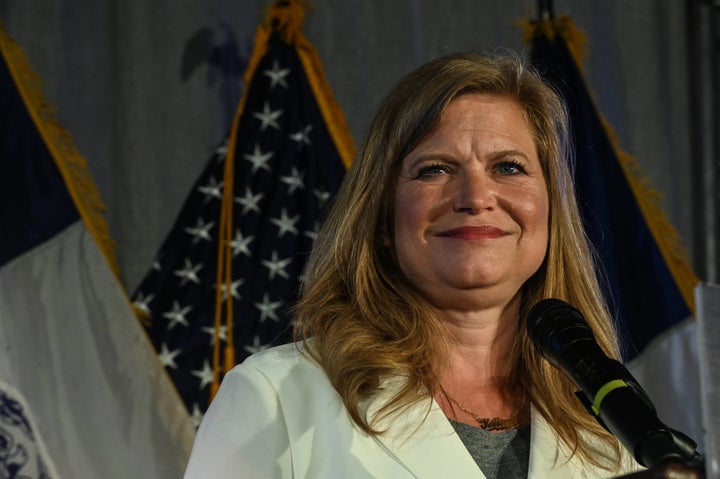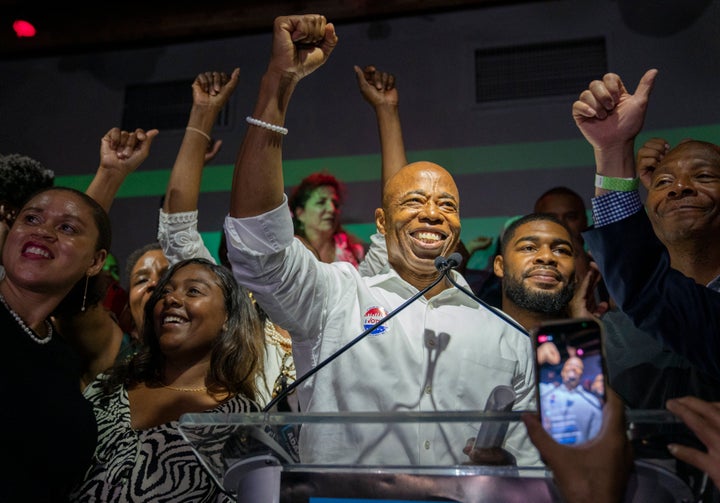Kathryn Garcia trails Eric Adams by a narrow margin in New York City’s Democratic mayoral primary after the city’s Board of Elections ran results through the ranked-choice voting system, eliminating candidates until only two were left.
Following 11 rounds of elimination, Adams, the Brooklyn borough president, leads Garcia, the former sanitation commissioner, 51.1% to 48.9%.
The results remain unofficial, because they do not account for the roughly 125,000 absentee ballots that Democrats have submitted.
A week after Election Day though, there is something positive for both Adams and Garcia to highlight in these preliminary returns: Adams retains his lead, but Garcia surges from third place to within striking distance of Adams.
There is even a silver lining for Wiley. Civil rights attorney Maya Wiley was eliminated in the 10th round while trailing Garcia by 0.5 percentage points. That leaves more than enough absentee ballots to push her back into second place ― or even the lead.
As of Sunday, 55,000 of the absentee ballots submitted to the board of elections were from state Assembly districts won by Adams, 39,000 from districts that Garcia won, and 17,000 from districts that went for Wiley, according to an academic analysis of returns published in the New York Post.
“We are incredibly hopeful about the 124,000 absentee ballots that are out there,” Garcia said at a Tuesday press conference. “Many of them came from electoral districts that I did well in.”
“But we’re going to have to wait until they all get counted,” she added. “That is what I intend to do. I’m certainly not counting any chickens before they hatch.”
On election night, before the start of the ranked-choice elimination process, Adams had 31.7% of first-choice votes, compared with 22.2% for Wiley, and 19.5% for Garcia.
Wiley, who appears to have lost ground since election night, released a statement suggesting that she is waiting for official results that account for absentee ballots.
“I said on election night, we must allow the democratic process to continue and count every vote so that New Yorkers have faith in our democracy and government,” she said. “And we must all support its results.”
Adams, for his part, has acted like he already won, proclaiming himself the “face of the new Democratic Party.” At the same time, he has promised to respect the final result of the ranked-choice process, suggesting that he would retire from politics if he ends up losing.
On Tuesday, Adams expressed concern that Board of Elections tallies included over 100,000 additional in-person votes than it showed on election night.
“We have asked the Board of Elections to explain such a massive increase and other irregularities before we comment on the Ranked Choice Voting projection,” he said in a statement. “We remain confident that Eric Adams will be the next mayor of New York because he put together a historic five-borough working class coalition of New Yorkers to make our city a safer, fairer, more affordable place.”
Adams has good reason to ask questions. On election night, with 96.6% of the total in-person vote tabulated, the Board of Elections stated that 799,827 people voted in total. That meant that there were 28,151 in-person votes outstanding.
But Tuesday’s unofficial rally included an additional 142,005 votes.
“We are aware there is a discrepancy in the unofficial RCV round by round elimination report,” the Board of Elections said in a statement posted to Twitter. “We are working with our RCV technical staff to identify where the discrepancy occurred.”
Garcia, who campaigned with entrepreneur Andrew Yang in the final days of the race, cast no such aspersions on the results. Yang instructed his voters to rank Garcia second, which appears to have helped her. She received more of Yang’s in-person votes than any other candidate after Yang was eliminated.
Garcia would not say at her press conference whether she believes definitively that the alliance with Yang helped her. But she did tout their collaboration as a benefit of the ranked-choice system.
“I was very happy to campaign with Andrew. He brought a lot of joy to this race ― and a lot of enthusiasm,” she said.
In a ranked-choice voting system, voters have the opportunity to rank five candidates in order of preference.
Then, the votes are counted in multiple rounds. In each round, the worst-performing candidate is eliminated, and that candidate’s voters are redistributed to those voters’ next-ranked choice. The winning candidate is the first person to reach a majority of votes through this multi-round elimination system.
Proponents of the system argue it gives voters more options, avoids situations where a candidate prevails with a mere plurality of the vote, and requires candidates to campaign more cooperatively.
The lengthy nature of New York City’s vote counting process has prompted griping from voters and commentators, including some suggestions that ranked-choice voting system is to blame.
In 2019, city residents approved a referendum adopting a ranked-choice voting system, and last Tuesday’s primaries were the first major, citywide contests for which the new system was in effect.
But the complexity of the vote counting is mostly a function of new rules making it easier to cast a vote via absentee ballot, rather than the ranked-choice voting (RCV) system.
“This is all very pro-voter and has nothing to do with RCV,” said Susan Lerner, executive director of Common Cause New York and head of Ranked Choice NYC, a coalition that supports ranked-choice voting. “Democracy is always worth waiting for.”
As the COVID-19 pandemic engulfed New York in March 2020, New York Gov. Andrew Cuomo (D) loosened absentee ballot requirements such that any state resident concerned about contracting the novel coronavirus could use “illness” as a valid reason to request an absentee ballot.
In August 2020, Cuomo further expanded absentee ballot access by allowing people’s absentee ballots to arrive up to seven days after Election Day, provided that there is evidence that they were mailed by Election Day. (Under the new law, a time stamp showing when it was mailed, rather than an official postmark, would suffice.)
In addition, state Sen. Zellnor Myrie (D) spearheaded passage of a law in August requiring local election authorities to notify absentee voters if their ballots have stray markings or other errors that would disqualify them. These absentee voters then have seven business days to correct ― or “cure” ― an absentee ballot.
At the same time, state law still prohibits local election authorities from counting absentee ballots they have already received until after Election Day.
To the disappointment of ranked-choice voting proponents, the New York City Board of Elections has still decided to subject existing ballots to the ranked-choice elimination process and provide periodic updates, rather than wait for all absentee ballots to be counted. Final results are expected to be made public by July 12.
Source: Read Full Article

